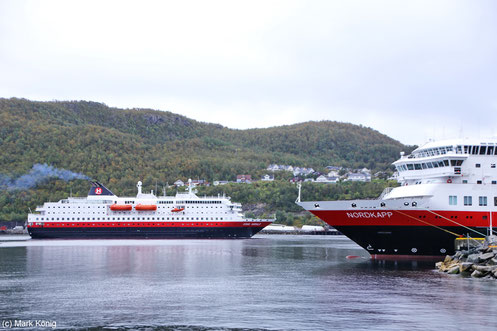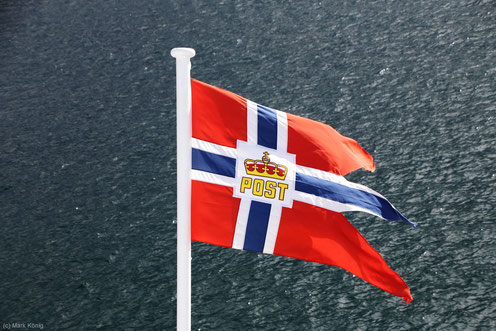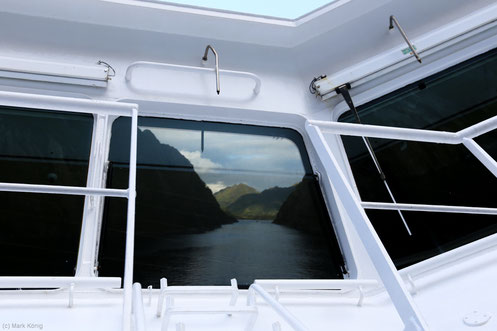HOW TO USE Hurtigruten ships best for a scenic car round trip in Norway
The Norway coastal line "Hurtigrute" is very useful for car round trips and as a transport option from port to port. But Hurtigruten ships are very different to car ferries. Of course many coastal vessels can also transport cars as well as freight and passengers. However, not only the lower loading capacity is a major difference. For travelers it is important to understand how the Hurtigrute is working and what that means for traveling Norway.
How does the Hurtigrute coastal vessel line work?
The Hurtigruten coastal vessels work like a bus line, on which several ferries are used according to a fixed timetable between start and end stations in two directions.
Basic information for the Hurtigruten coastal line. Online booking for port-to-port is only available on Norwegian website.
- Starting point South: Bergen, Norway
- End point North: Kirkenes, Norway
- Journey time one-way:
- Northbound Bergen - Kirkenes 7 days (6 nights)
- Southbound Kirkenes - Bergen 6 days (5 nights)
- Journey time for round trip: 12 days (11 nights)
- Frequency: One ship per port per day to north and to south
- Number of ports to be approached (stations): 34, but not all ports are approached in both directions and at all seasons (see timetable).
- Timetable: Summer and winter timetables differ: a few ports are not included in winter sauling plan. Link to timetable here.
Future: From 2021 to 2030 a second provider will serve the public transport coastal route (called "Hurtigrute"). From this point of time the company "Hurtigruten" will face competition on this route.
Advantages of the Hurtigrute Coastal LINE for Car Travelers In Norway
A partial journey with Hurtigruten contribute some advantages to a car round trip. I can tell from my own experience that I found it very pleasant, after thousands of self-driven kilometers to be driven from Kirkenes back to Trondheim.
- More destinations and range: Coastal vessels connect more than 30 ports in Norway every day; and that on very large distances of well over a thousand kilometers.
- Experience: A ship trip along such an attractive coast is always a special experience. In addition, the Hurtigruten offer over 100 excursions for an extra charge, which extend the experience even further.
- Other perspectives: From the ship you can see landscapes you would never reach by car. Especially for landscape enthusiats and for photographers this is the main benefit.
- Reliability: There is a fixed sailing plan and this is strictly pursued - almost at "every" weather. Therefore you can also plan without hesitation with the planned departures and arrivals for the further journey. Only at risk ports will be skipped - safety first.
- Relaxation: After check-in, it is a relaxed way of tralling because of the high comfort on board the ships. On outside decks, in the restaurant or in the panorama salon: the landscape is passing by and you have time to enjoy it.
- Flexibility of usage: Whether you want to go all the way, a partial route or only from one station to the next. Everything is possible. In ports you can also just leave the ship for a short time - but be back right on time.
- Worth the price: Many consider the Hurtigruten as expensive. They are also - and yet it can be worth the price. In my case, it would have been 1,600 km with the shortest route and 20 hours of driving - through Sweden. Actually compared it would have been about 2,500 km and about 40 hours. Pricewise, the Hurtigruten were not much more expensive, but faster, a ver special experience and despite two days of strong wind with proper swell of sea very relaxing.
Tips For Short Trips with Coastal line ships
Like other ways of public transport you can also book only from one port to another, so that in the simplest case you can travel without a cabin. This way you can spend a day on a Hurtigruten ship, getting around through scenic landscapes and enjoy the amenities of a mini cruise.
- A well-known tip is the southern route from Harstad to Svolvær on the Lofoten. At good weather and with some luck, the captain gives a trip to the narrow Trollfjord, which can not be reached by car.
- From Honningsvåg to Tromsø is a long day on board, but you save 500 kilometers of road (about 8 hours).
- In northern direction the route from Trondheim to Svolvær on the Lofoten is possible with one overnight stay. This saves at least 14 hours of driving for over 800 kilometers on land plus ferry times.
A map of all ports and real-time positions of coastal line vessels from Hurtigruten can be found here.
Main Differences Between Car Ferries & Coastal line ships
Coastal vessels and car ferries - both can transport cars but it is a big difference in usage and experience from a traveler perspective, especially with car:
- Number of ports and range: The coastal vessels connect more than 30 ports at a distance of more than 1,500 kilometers.
- No pure focus on transport of vehicles:
-
- Only 10 of 13 Hurtigruten ships on the route have a car deck. Three can not transport cars, e.g. the older MS Lofoten.
- Trucks, buses and motorhomes can not be transported.
- Less capacity: Coastal vessels with car deck can carry about 20 - 30 cars. For comparison: car ferries of the same size can transport about 180 - 200 cars.
- Lower frequency: Only one ship per day per port per direction (so 1 x north and 1x south every day in planned port).
- Cars are side-loaded one after the other: the side loading ramp and elevator allows only single car de- and embarking compared to the mass bow and stern loading of typical car ferries ("RORO ferries").
- The car is not parked by yourself, the staff is doing that.
- During the journey one car key remains with the staff.
- The car is not freely accessible after dropping on the car deck.
Tips For Traveling By Car On A Hurtigruten Coastal Vessel
If you know the differences, it is also very well possible to prepare yourself and to facilitate yourself a pleasant journey.
Before The Day Of Departure
- Ensure to book beforehand: It is mandatory to book the passage in advance - especially if you want to take the car with you. For travel in main season book as early as possible. You should not try, just drive to the ship and try on good luck, because not all ships have a car deck and possibly there are only few places, which are partly booked weeks before. In addition, there is "only" one ship per day and direction (north or south).
- Print the booking confirmation and documentation for the passage and place it in the vehicle.
- If necessary, bring appropriate bags and boxes with you so that you can have your things on board together and transport them. Some ships have lockers available.
- Charge your mobile phones and cameras in advance for that day to enjoy a day at sea with many photos.
On The Day Of Commencement Of The Trip
-
Preparing devices such as cameras and smartphones:
- Charge the batteries of cameras and smartphones.
- Back up data if the device gets lost.
- Optional: If applicable and wanted, activate GPS on your smartphone and cameras.
- Ticket / Booking Confirmation on Smartphone or have it printed and stored in a convenient way.
- Prepare luggage: Pack all items you might need on board handy: warm clothes, medication, scarf, cap, food, drinks, sunglasses, cuddly toys, cameras, chargers, ID cards, money, credit cards, etc. - because you don't park your car yourself and after leaving the elevator ramp everything needs to work "hurtig" (= fast). Remember, you can not get to your car until it is unloaded at the destination port.
- Be at least 30 minutes before departure of the ship with the printed ticket at the port and contact the staff.
- Use the waiting time at the pier to check your baggage, whether you have everything you need. Do your own documentation of car status by taking pictures of the condition of your vehicle.
- Upon request of the loading personnel you drive yourself to the laterally opened loading ramp. Each car is individually lowered into the interior of the ship.
- After exiting the loading ramp inside the ship interior, the staff will take the vehicle from you including keys for parking. You do not park yourself. The staff also takes pictures of your vehicle during the takeover itself, in order to document the status on takeover. One car key remains with the staff.
- Now take everything out of the vehicle with you, which you need on board during your stay: ID cards, telephone, money, medicines, chargers and possibly cuddly toys. You will not get to your vehicle during the journey to pick up something you may have forgotten.
- Head to the reception and check-in on board.
- You and all your fellow passengers will get a plastic card for identification on board.
- Optional: If you deposit a credit card at check-in, you can also use this board id card to pay smaller amounts on board. It also speeds up the payment process, however, it is like cash for others when you lose that card.
- Important: Aquaint yourself at least with the most relevant safety features and precautions on board.
During The Travel/Journey
- Explore the ship: In addition to the usual staging points such as panorama deck, bistros and sun deck, there is usually a deck where you can go around the ship on the outside.
- With your board identification card (and only with it), you can leave the ship in ports and re-enter, e.g. for a short walk or shopping on land. Ensure to be back on board bight before time of departure, as the ship will not wait for you.
- If you lose the board identification card (plastic card), you shall contact the reception immediately.
- You should pay attention to your valuables and objects especially in ports, as everyone can come aboard during the waiting period. There are lockers on board. May be store some bigger items there.
At the Port Of Arrival
- When the ship arrives at your destination, take all your luggage (remember lockers) and checkout at the reception. Do not forget to ask for your car key. Then you leave the ship by foot via the pedestrian gangway.
- Your car is unloaded and driven onto the port's pier by staff, may be before you have left the ship.
- Remember to check for damages and to have handed over the car key. Take care: On land, everyone else could wait and say "Thank you for my car". If your car is already unloaded when you have debarked the ship, you have to return to the reception for receiving back your car key.
- Important tip for this reason: After your car is unloaded, keep eyes on your vehicle! Without further check I was handed over the keys of another person's car of the same type. I would have been able to drive off without difficulty or at least to take valuables out of it. (Urgent need for improvement).
- Check your vehicle for possible damages when handing over or before driving off the area at the latest.
- Optional: Disable GPS on smartphones and cameras.
More Practical Tips For Traveling With Hurtigruten Coastal Vessels
- You can of course also travel as a pedestrian or bicyclist (without a car) on a coastal vessel.
-
- Tip: In the summer on northbound route the ship stops twice in Ålesund. In the morning before getting into fjords and in the evening after the fjord tour. That way is also an option to use a Hurtigruten ship as a fjord tour during one day.
- Some of the ports in quick succession are connected by bus, e.g. on Lofoten and Vesteralen which allows a public transport round trip.
- Of course, it is also possible to "change" and return the same route with another coastal vessel, e.g. in Svolvær, the ship of the southern route leaves approx. 30 minutes before the ship of the northern route reaches the port.
-
Weather: Check out the expected weather, e.g. at Yr.no (link here).
- Suitable clothes: Take warm clothes with you. At sea, the temperature is usually cooler than on land, take also in consideration that winds can be stronger at the open sea.
- Swell: A ship can also swaying. The coastal vessels are very robust and also large enough to sway not from normal waves. However, weather in Norway can become significant quickly.
- Protect your ears and do not be frightened by sudden ship's horn: Even after one or two days on board I did not get used to the loud toot of the ship when entering a port (at night this does not happen). Also encountering coastel vessels greet each other in this way.
- Protect from the sun: Sun is reflected on the sea surface. So if you are standing on the railing, you will get an increased amount of sun.
- Protecting own property: Especially in ports, remember that strangers can also come on board as a guest for a short time. In particular, do not leave your belongings unobserved.
- Mobile phones at sea usually have no or only a bad and unstable connection to a mobile network on land. Therefore, do not plan important phone calls and be prepared that the map and navigation services of your mobile phone do not work if they are dependent on the loading of map data to a GPS position. It is recommended to use map services which already have data in the memory of the smartphone (offline maps) or at least partially store these. WLAN on board did not work for me with two of two trials.
- Prepare to geo tag locations to photos later on:
-
- Remember to enable GPS on your smartphone and also in the camera app settings.
- If necessary, use a GPS Tracker app that detects your position and records it on a map every minute. This allows you to assign photos without GPS information at a later time, e.g. "GPS Logger".
- Also make sure your cameras and your smartphone display the same time.
- Prevent misunderstanding by really check-in with your booking reference at reception when embarking at port of departure: If you are not traveling alone, all your fellow passengers can enter the ship via the pedestrian gangway and check-in at the reception. But do not just go on board by receiving a guest card handed to you at the entrance, otherwise the misunderstanding will be pre-programmed when you want to leave the ship, that you wanted to sneak a passage, because the assignment of you to your booking is missing.
Links
- Links to current information in Norway - Weather, Transport, Local: https://www.mark-koenig.de/2017/07/03/daily-use-links-for-tourists-in-norway/
- Hurtigruten:
-
- Booking of coastal vessel travel: https://www.hurtigruten.com/port-to-port/
- Timetable of coastal vessel line: https://www.hurtigruten.com/practical-information/sailing-plan/
- Map view of the position of ports and ships: https://www.hurtigruten.com/map/#norway
- Excursion selection of the Hurtigruten: https://www.hurtigruten.com/excursions/#sort
- Weather Service Norway: https://www.yr.no
- Travelling to Norway by car
Pictures & impressions
(c) Author: Mark König; with special thanks to Julia Weihe for editing and translation support
If you would like to share your experiences of coastal vessel voyages with a car, you are highly welcome to leave a comment.




















